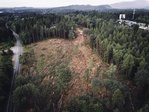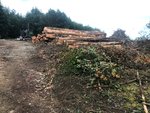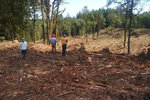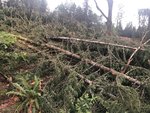



In June, neighbors near 20th Avenue NW and Cooper Point Road were surprised by a logging operation about which that they had had no meaningful notice. Many trees in a beautiful, forested area were being logged, and few answers were found at the time.
The 25 acres of Green Cove Creek Watershed are also the site of a high-pressure aquafer and an aquifer recharge site. Last week the conservation group Olympia Coalition for Ecosystems Preservation (OlyEcosystems) acquired the land. In its Facebook notice about the acquisition, “A forested wetland on the highest hill of Olympia is no more. Over 25 acres … were clearcut in July 2022.”
The post says, “Clearcutting destroys an area's ecological integrity in many ways. Our forests provide abundant and pure water, a stable climate, wildlife habitat, and clean air. This area includes the headwaters of one arm of the Green Cove Creek, which is Olympia's best potential salmon recovery habitat.”
“We felt obligated to do something. [It is] a really, really important watershed. It is our best bet at salmon habitat recovery, and someone needed to step up, so we stepped up, and I'm grateful to the Bowen Conservancy for backing us up. There’s a lot of hard work ahead of us,” related Daniel Einstein of OlyEcosystems.
Investment property to logging to break even
To recoup their investment in the property, Marty Wicklund of Silvimantle LLC said that by logging and selling, they’d be able to recoup everything. “We cut Douglas fir, western red cedar, a little bit of red alder, and a little bit of maple. We'd left the vast majority of the maples on the property and anything that was not merchantable or involved in safety.”
Too expensive to develop
Reached on July 6, Wicklund told The JOLT, “I doubt a developer is going to buy it… a developer came to us and was interested in pursuing it about six months ago, and they hired an engineering firm to do an analysis of all of the capital improvements that the city of Olympia was requiring. And that number was over $9 million to develop the property with all the improvements, and they couldn’t justify the cost.”
In the investment business
Wicklund said, “We're in the business to invest in properties. And quite frankly, when we looked at the property, we thought it was an incredibly beautiful piece of property. Our initial goal ... has been to sell it to either a land trust or the City of Olympia for parks. We never ever wanted to log it. That was not our goal."
Speaking further about the property, Wicklund said, "This is a beautiful piece of property. Legacy type of forest. It's older. That's a 95-year-old stand of trees. This should be saved and kept in the city. And we went through all three of these potential opportunities to sell it [to a conservation organization or to the city], and every single one of them said that it's not a high priority for us. We just don't want to buy it."
"People may find it hard to understand or believe, but every person I've brought out there, whether it's a surveyor, whether it's a wetland biologist, whether it's a logger, they've all they all walked through and go ‘God, I can't believe no one's bought this. Why hasn't the land trust?' I look at them, and say 'I can't tell you. I don't know why they all say it's not important,'” Wicklund added.
“At the end of the day, we ran out of time for our investors in general. We have four of them and they were all like, 'Hey, we need to get our money back.' The log market's very strong. And we needed to move forward," Wicklund said.
Trees vs safety
“I would have loved to have left more trees in the units; however, the Washington Department of Labor and Industries (LNI) frowns upon that, and if we leave too many trees while we're harvesting, they can give the operator, our landowner, a fine,” Wicklund detailed.
According to Wicklund, LNI considers it too dangerous for operators to be on a property with pockets of trees if they because of the possibility of the trees coming down on the operator. “It's a situation where they [LNI] make the call. The landowner is sometimes very frustrated because you would like to leave more trees on the property. [The operator] will get a warning once, and then they'll start issuing fines,” he explained.
“On this property, particularly the north parcel, there was a relatively significant amount of dead trees, mainly cedar trees standing, and they call those ‘snags’ in our vernacular, and LNI is especially concerned with snags because they can fall very easily. So they rarely allow you to leave the snag. It's all about safety,” Wicklund said.
Conservation and replanting
Einstein said that they have a purchase and sale agreement executed. He continues, “we concluded the purchase. [It] has been recorded with Thurston County.” He noted that the data should show up in a week or two, however long it takes for the Assessor’s office to process it.
The money to make the purchase happened quickly, according to Einstein. “We sort of caught lightning in a bottle. We've worked with the Angela J. Bowen Conservancy Foundation previously. That's the foundation set up by Dr. Angela Bowen’s estate. We were able to successfully solicit funding from them to execute the purchase and sale.
Not all funded
“It's a tragedy, the whole thing is a tragedy, but if we had had another couple of weeks, we would have probably been $150,000 short of being able to buy the property intact. Everything happened just so quickly,” Einstein laments. “Had we had more time? I believe we would have been able to [partner with the city and possibly others] to put together the funds.”
According to Einstein, the Bowen Foundation provided the funds for this purchase. The price of the property was $225,000, according to both Wicklund and Einstein. OlyEcosystems had been quoted a higher price before the trees were cut, and the price was reduced significantly after the harvest.
When talking about the company from which they purchased the property, Einstein said, “I think they got out of the property what they wanted to get. And they could have gotten more. They recognized the controversy that had been stirred up and wanted to work with us.”
“Of course, for us financially, this is only the beginning. [Over the years], we're gonna have to put hundreds of thousands of dollars into this property to make it close to right,” Einstein said. He continues, “That's funding that we currently don't have. We do have some funding to help address critical erosion control and get us through the winter.
The Forest Practices permit that the property is subject to states that they have to have 350 trees per acre, Einstein related. “We have to get those trees [planted] in December at the latest because… the more time the trees have in the wet, the better off they are and the better they're going to be able to tolerate the summer drought that will come in 2023.”
Controlling the site
“We have to do a lot of erosion control. There are probably 30 slash piles that we have to do [for erosion control]. There are some steep slopes on the property that we're concerned about. We're concerned about erosion from the road,” Einstein states.
The streams and aquafer
“There are springs and seeps all over the property, and the northern four or five acres are wetland. There’s standing water there now. The creek that was… controversially crossed off the map here was a seasonal creek,” Einstein related.
With cool, wet areas, the forest retains water and continues contributing groundwater to Green Cove Creek, Einstein said, adding that the creek “has a fish population in it over the summer months. In-stream flow is something that people who are concerned with fish habitats are concerned with. There has to be a certain amount of base flow year-round to support salmon development in the summer months.”
Wicklund maintains that while there was a stream shown on the map, "there was no stream on the property, he said, adding "there was no channel, as noted by myself, the DNR forester and the Washington Fish and Wildlife biologist."
Uncertainty
“I don't think anybody really knows what's going to happen over the wintertime,” Einstein says. “We're going to use best practices, and we're going to limit erosion. At this site, it’s not all about surface flows. It's an aquifer recharge zone. And water is going to move through the site much more quickly than it has in the past.”
Land off limits to the public – for now
For now, there will be no walking in this forest; Einstein relates, “it's just not safe. Yeah, so we're, you know, we're encouraging people to stay off. We’re going to be doing is meeting with the [Olympia] Parks Department next week to discuss public access. We don't want the public to be on there until it's safe for them to be on there.”
With it being clear that people will want to walk there, at some point, it will be possible to put a path back on the property, Einstein shared. “With the idea that if there is going to be public access, and it's uncontrollable, it's better to channel [that] in a positive way.”
“I think there's a lot of opportunities for involving the local universities and involving the public in research and restoration,” Einstein continued, “there's an opportunity to really put a spotlight on the green Cove Creek watershed as a result of this situation. It's going to take some time, and people are going to have to be patient.”
CORRECTIONS - August 6, 2022: A previous version of this story stated that the purchase prices of the land was higher than the $225,000 paid by OlyEcosystems. We also added a comment by the seller to this update and made typographical and grammatical corrections. We regret these errors.
3 comments on this item Please log in to comment by clicking here
BobJacobs
The Department of Natural Resources procedures need serious scrutiny? What's with allowing the owners to simply cross a stream off the map so they can cut trees? And why are local governments not allowed to be involved in permitting? I hope the legislature will take a serious look at this.
Bob Jacobs
Saturday, August 6, 2022 Report this
Southsoundguy
Sounds to me like awkward government imposed incentive structures lead to a sub-optimal outcome. Let owners manage their land.
Sunday, August 7, 2022 Report this
FirstOtter
Logging my foot. That's clear cutting, and for Wickland to blame L & I,saying it's ''all about safety" is just so much BS. They ****d that forest for the money and the consequences be damned. Wicklad's boohooing about how his LLC needed to 'recoup' his investment...why? Same ol' noise-"we didn't want to log it but the shareholders insist?" My foot. Wickland bought that property for the sole purpose of stripping it and then leaving...like so many other developers. Greed. Greed Greed.
Tuesday, August 9, 2022 Report this